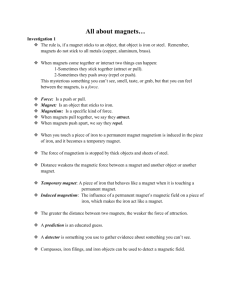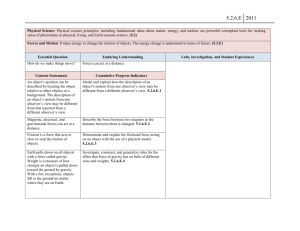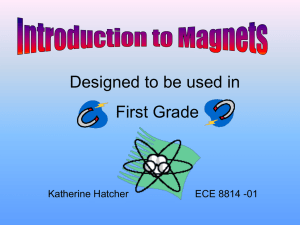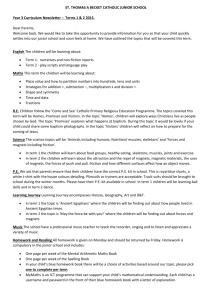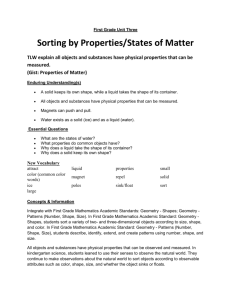Magnets and Springs
advertisement
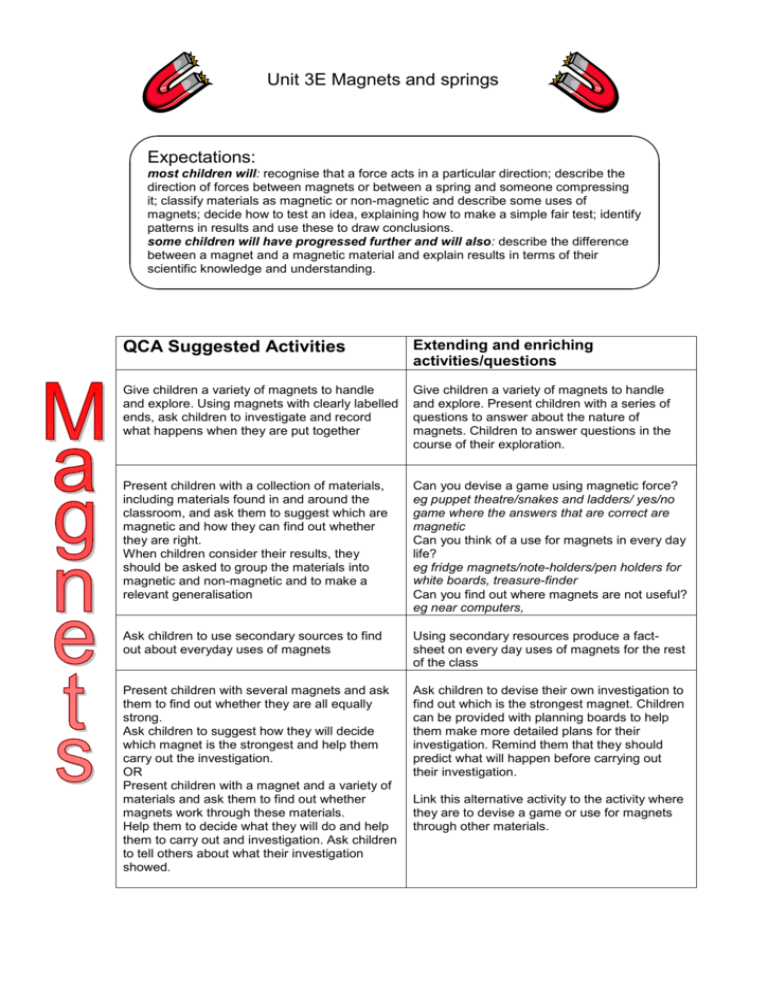
Unit 3E Magnets and springs Expectations: most children will: recognise that a force acts in a particular direction; describe the direction of forces between magnets or between a spring and someone compressing it; classify materials as magnetic or non-magnetic and describe some uses of magnets; decide how to test an idea, explaining how to make a simple fair test; identify patterns in results and use these to draw conclusions. some children will have progressed further and will also: describe the difference between a magnet and a magnetic material and explain results in terms of their scientific knowledge and understanding. QCA Suggested Activities Extending and enriching activities/questions Give children a variety of magnets to handle and explore. Using magnets with clearly labelled ends, ask children to investigate and record what happens when they are put together Give children a variety of magnets to handle and explore. Present children with a series of questions to answer about the nature of magnets. Children to answer questions in the course of their exploration. Present children with a collection of materials, including materials found in and around the classroom, and ask them to suggest which are magnetic and how they can find out whether they are right. When children consider their results, they should be asked to group the materials into magnetic and non-magnetic and to make a relevant generalisation Can you devise a game using magnetic force? eg puppet theatre/snakes and ladders/ yes/no game where the answers that are correct are magnetic Can you think of a use for magnets in every day life? eg fridge magnets/note-holders/pen holders for white boards, treasure-finder Can you find out where magnets are not useful? eg near computers, Ask children to use secondary sources to find out about everyday uses of magnets Using secondary resources produce a factsheet on every day uses of magnets for the rest of the class Present children with several magnets and ask them to find out whether they are all equally strong. Ask children to suggest how they will decide which magnet is the strongest and help them carry out the investigation. OR Present children with a magnet and a variety of materials and ask them to find out whether magnets work through these materials. Help them to decide what they will do and help them to carry out and investigation. Ask children to tell others about what their investigation showed. Ask children to devise their own investigation to find out which is the strongest magnet. Children can be provided with planning boards to help them make more detailed plans for their investigation. Remind them that they should predict what will happen before carrying out their investigation. Link this alternative activity to the activity where they are to devise a game or use for magnets through other materials. Example Plan Our investigation: Which is the strongest magnet? The factors we could change Size of magnet Type of objects to be attracted The factors we could measure/observe Type of magnet (horseshoe/ bar/fridge etc.) Number of metal objects attracted to magnets. Distance a paper clip can be attracted to magnet in cms and mms. Materials through which magnets will attract objects. Layers of materials through which magnets will attract objects. Number of paper clips/metal objects attracted to magnet. We will change Group planning board The type of magnet Distance magnet can be moved towards objects before attracting. Thickness of materials through which magnet will attract. Mass of objects attracted to magnet. We will measure/observe Distance a paper clip can be attracted to magnet in cms and mms. Our question is…Does the type of magnet affect the distance paper clips can be attracted to the magnets. We will keep these factors the same… Size of magnet Number of metal objects attracted to magnets. Our prediction is……… When we change The type of magnet Type of objects to be attracted Materials through which magnets will attract objects. Layers of materials through which magnets will attract. What will happen to Distance of attraction. Why? We think that the bar magnet will attract the paper clip from a greater distance because the magnetism is stronger than in the other magnets. Plan Our investigation: Group planning board Which is the strongest magnet? The factors we could change The factors we could measure We will change We will measure/observe Our question is… We will keep these factors the same… Our prediction is……… When we change Why? What will happen to Unit 3E Magnets and Springs On a blank sheet of paper draw a maze from one end of the paper to the other. Once the maze has been drawn, place the paper clip at the start of the maze. Ask a friend to hold the piece of paper in the air. Hold a magnet under the paper and below the paper clip. Try to move the paper clip through the maze without touching the lines. Why not try to draw your own maze? Unit 3E Magnets Learning outcomes given a magnet of unfamiliar shape, or with unlabelled ends, demonstrate how it is attracted to, or repelled by, another magnet. generalise about what happens when magnets are put near one another or together, using scientific terms eg attract, repel classify a range of materials, including metals eg gold, copper, aluminium, as magnetic or non-magnetic and explain how their work enabled them to do this make a generalisation about magnetic behaviour eg iron is magnetic but other metals aren't, materials that aren't metals aren't magnetic, only some metals are magnetic describe and explain how magnets can be used eg in recycling, you can sort iron from other things because it is magnetic explain how their test is fair eg using the same size paper clips or the same magnet each time make accurate observations or measurements eg of the number of paper clips picked up or of the distance between the magnet and the paper clips explain what their results show eg I thought the biggest magnet would be strongest but it only picked up six clips. The smallest magnet picked up eight so it was strongest, I tried different thicknesses of card but the magnet worked through them all but it didn't work through an iron can lid Able outcomes explore magnets and use their findings to answer many questions about magnets use correct scientific vocabulary to describe their findings eg Can you take two magnets and try to push like poles together? How far away do you start to feel the repulsion? How does the force vary with the distance between them? When the magnets are moved off-axis to each other (moving them to the side and not head on) what does it feel like? Could you think of a way to describe it (eg like trying to push two tennis balls together?) When you flip one around, what changes? What about moving one around the other in a circle? use their knowledge of magnetic materials to devise a game about magnetic and non-magnetic materials name materials that are magnetic and those that are not eg tins made of aluminium are not magnetic, other tins made of iron are magnetic describe and explain a wider variety of uses for magnets eg lifting, sorting, cars etc. devise a fair test to investigate the strength of different magnets make accurate predictions that can be compared to their results make decisions about what measurements are to be taken. Make accurate measurements use their results to explain their conclusions Magnets Exploration Present children with a range of magnets including those the children have been asked to bring from home or have discovered in school. As children explore magnets ask them to think about questions they might be able to answer. Children could try to answer each question before they explore the magnets. Children will be asked to provide the answers later in the lesson. (Examples of possible questions are listed below.) Can you push like poles together? How far away do you start to feel the repulsion? How does the force vary with the distance between them? When the magnets are moved off-axis to each other (moving them to the side and not head on) what does it feel like? Can you think how you could describe what it is like to push like poles together? Could you describe it like trying to push two tennis balls together? When you flip one around, what changes? What about moving one around the other in a circle? Describe what happens. Some of the basics of magnetism, children might discover by exploring, is the north pole of the magnet points to the geomagnetic north. north poles repel north poles south poles repel south poles north poles attract south poles south poles attract north poles the force of attraction or repulsion varies inversely with the distance squared the strength of a magnet varies at different locations on the magnet magnets are strongest at their poles magnets strongly attract steel, iron, nickel, cobalt, gadolinium magnets slightly attract liquid oxygen and other materials Unit 3E Magnets and springs magnets slightly repel water, carbon and boron and so on Unit 3E Springs QCA Suggested Activities Extending and enriching activities/questions Ask children to make a list of examples of where springs are used at school or at home. Where are springs used in the outside world? Ask children to pull springs and elastic bands and to push springs and to describe the direction of the force on their hands. Explore variety of springs and group or order them according to different amount of force. Show children how to make a catapult or ‘push meter’ using elastic bands to propel a toy car or weighted container along a flat surface and ask them to predict what will happen if the bands are stretched by different amounts. Help children to decide how to test their predictions. Ask children to record measurements in a prepared table and to look for patterns in the measurements. Ask children to explain why stretching the band more made the toy car or the container move further. Give children a manufactured push meter and ask them to make a model of one using materials in school eg cardboard cylinder, elastic bands, stick on which to write some form or readings Use their ‘home-made’ push meter to measure the force needed to push various objects. Compare this with the real push-meter. Extend the investigation by using bands with different thickness. Ensure the children record accurately and use their evidence to make generalisations eg the thicker the band the further/less far the car went. Ask children to make a concept map involving ideas such as magnet, repel, attract, force, spring, elastic, pull towards, push up on, direction, stretch, compress, size of force, push harder. Ask children questions about their maps with them emphasising the idea of force. Unit 3E Springs Learning outcomes Able outcomes name a variety of examples eg stapler, mattresses, chairs, retractable pens where springs are used describe the effect of the elastic band or spring eg when I stretch the band down, I feel a pull up on my hand or when I squash the spring down, it pushes up on me name more unusual examples for springs make creative suggestions about other places where springs could be useful explain the forces at work when an elastic band is stretched or a spring is compressed make a prediction eg I think if I carry out an investigation on the stretch the band more, it will go stretch of elastic bands, including further prediction, comparisons and make comparisons eg when I used a accurate data big force it went further and identify use their findings to explain what patterns eg the more I stretched it, happened the further it went explain that the more the band is stretched, the bigger the force eg when I pulled the band a long way out, the car went further because there was a big push on it



